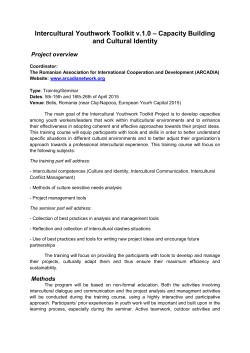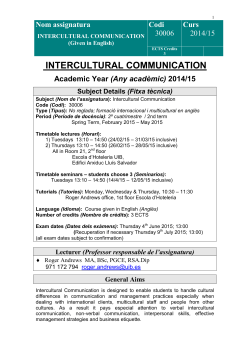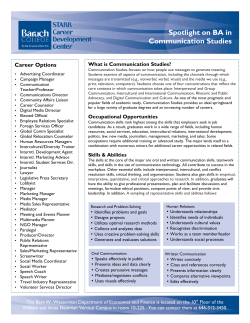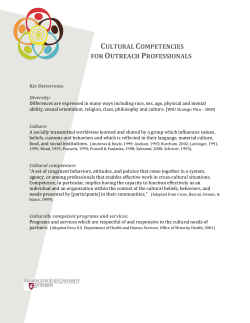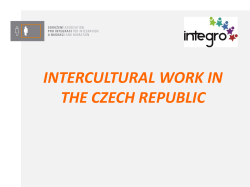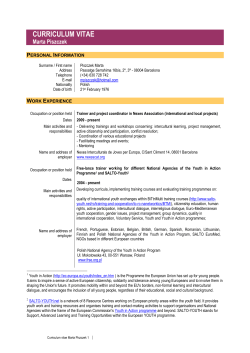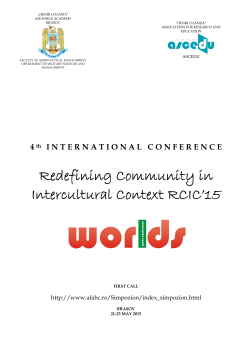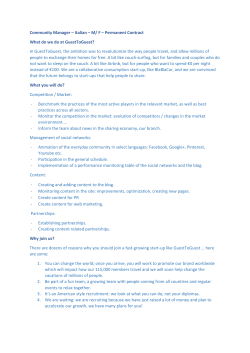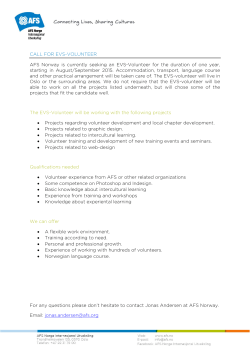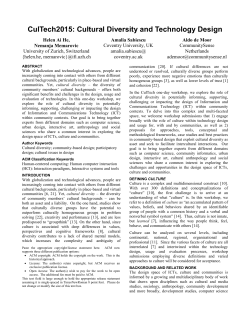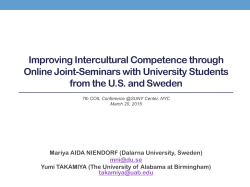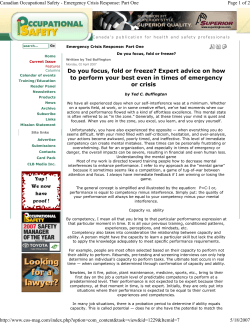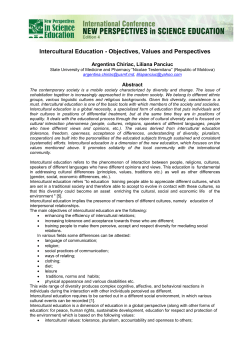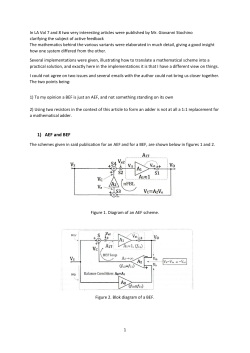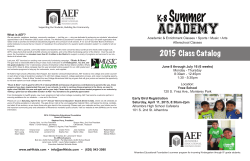
Intercultural Understanding: Developing links with Asia Sarah
Intercultural Understanding: Developing links with Asia Sarah-Kay Coulter and Cleo Westhorpe Introduction In order for learners to thrive and contribute to a global marketplace, there needs to be opportunity within curriculum to authentically explore intercultural understanding in a meaningful way. With the emergence of a cultural ‘third space’ individuals are being asked to negotiate multiple cultures and identities; to recognise, appreciate, understand, and move together more cohesively. But how is it that young people develop world-mindedness? How can learning communities develop the competency of the student so they see core concepts from multiple perspectives? How can curriculum be created with inquiry so learners are provided with rich, contextualised, meaningful learning which provides an opportunity for a balanced dialogue? And within this: what about educators and education providers? Are they acting in a way which models intercultural understanding? How can critical reflection be encouraged so that perspectives and prejudices are exposed without judgement? Education is going global; a readiness for the future is a mandate within industry and enterprise. Prosperous human endeavour is inherently reliant on interconnectivity and a shaping of the future together. Technology has flattened the world and static boundaries are now dissolved. World citizenship is a reality faced today. The education of our young people is essential to create a sustainable global community. Dimensions of Character Traditional values, skills, dispositions and attitudes are being reshaped with global sensitivity at the fore. World-minded individuals and learning communities are building relationships to develop shared intentions that contribute to the greater good. Yet, there is something uncomfortable about the examination of self and others and a tension of priorities at a local and global level that challenges social and civic competency. Within this tension and uncertainty: possibility emerges. Fluency of intercultural understanding becomes imperative. Character development in relation to global citizenship is a continual dialogue. Literature (Arthur et al., 2006) indicates character formation across nine dimensions, namely: Spiritual and religious engagement, Living my virtues and values, Political engagement, Identity in relationship, Ambition, Meaning and purpose, Critical social justice, Challenge and Responsibility, Critical learning and Community engagement. This framework demonstrates the tensions apparent between who one is; who we are; and how we move together in action. Furthermore, developing a framework to explore global student and teacher competencies is paramount. Global competency can be defined as the knowledge and skills people need to understand today's ‘flat world’ and to integrate across disciplines so that they can comprehend global events and create possibilities to address them. Global competencies are also the attitudinal and ethical dispositions that make it possible to interact peacefully, respectfully, and productively with fellow human beings from diverse geographies (Reimers, 2009). Education entrepreneurs are developing practices that engender global competency, such as targeted foreign language curriculums, programs that promote intercultural competency, and outward-focused schools and curriculums. The globally competent teacher and student work together in their classroom to prepare the next generation for global civility and understanding. Mansilla and Jackson (2011) state that when educating for global competence, topics should demonstrate: deep engagement, clear local and global connections, visible global significance, and robust disciplinary and interdisciplinary grounding. A relationship with Asia In exploring the competencies outlined in the framework, it is apparent that this endeavour is collaborative in action and developing this mindset is fundamental for progression. This agenda cannot be served in a solo quest. Drawing on resources and experts beyond the school environment is deliberate to both localise and globalise thinking. Utilising networks to learn in reciprocity, within a realworld context provides authentic opportunity to develop affective skills. According to the Australia in the Asian Century White Paper (2012) when learning relationships exist there is opportunity for development, growth and economic prosperity. Within Australian education - Asia is an appropriate ground for intercultural exploration. Students and educators alike become learners in this place as preexisting labels are deconstructed, as essentially we are within uncertain ground. Outcomes are unknown. Building School Partnerships The BRIDGE Project through the Asia Education Foundation (AEF) provides funding to schools interested in exploring intercultural understanding and creating global partnerships. Below is a guide for developing partnerships of mutual benefit. Education is the result of relationships. When students are genuinely engaged in investigating the world, recognising their own and others’ perspectives, communicating ideas to diverse audiences, and taking action, they often encounter challenging ideas, unsettling facts, intriguing opinions, and exciting opportunities. The Becoming Asia Literate: Grants to Schools (BALGS) program aims to support the development of Asia literacy in schools Australia-wide through the provision of direct-to-schools grants for Asian languages and/or studies of Asia, and the program is part of the National Asian Languages and Studies in Schools Program (managed by AEF on behalf of the federal Department of Education) (AEF 2013). Source: AEF 2013, p.3 Research reveals that over recent years, there has been a re-emerging trend to internationalise Australian education by building intellectual and linguistic connections with international students from Asia, for it can no longer be considered inconsequential or peripheral to Australia's economic interests, not in the least because of the increasingly competitive international student market (Singh & Tamatea, 2012). Enshrining the Asian cross-curriculum priority has ensured that educators recognise the region’s importance on a number of levels. Source: AEF 2013, p.5 Partnershps building BRIDGEs School partnerships, such as those formed under the BRIDGE banner, aim to develop global citizens who demonstrate intercultural understanding and realise the importance of Asian-Australian connections for a better future. Digital technologies are embraced to provide opportunities for pedagogical exchange and improve the learning outcomes for all students. Building respectful and collegial partnerships within and between schools is fundamental to professional growth and improved opportunities for student learning (Harris, 2005). Partnerships can be difficult to conceive, build and maintain, therefore various factors can affect its success. Ensuring there is clear, honest communication and defined procedures and processes for engagement. Vitally important is a professional collaboration between educators imbued with trust. These professional relationships build the ‘social capital’ of a school and the wider network of schools (Fullan & Hargreaves, 2012 cited in AEF, 2013). A significant outcome of these innovative collaborations for all of the teachers involved is professional reward, mutual respect and personal nourishment (AEF, 2013). References Arthur, J., Deakin Crick, R., Samuel, E., Mcgettrick, B. & Wilson, K. (2006) Character education: The formation of virtues and dispositions in 16-19 year olds with particular reference to the religious and spiritual Canterbury Christ Church Canterbury University Asia Education Foundation (2013). What Works 5: Schools becoming Asia literate – what works? University of Melbourne Education Services. Accessed 23rd October 2014 http://www.asiaeducation.edu.au/verve/_resources/What_works_5_report.pdf Australian Government (2012). Australia in the Asian Century White Paper. Accessed http://www.asiaeducation.edu.au/verve/_resources/australia-in-the-asian-century-white-paper.pdf Harris, A. (2005). Teacher leadership: More than a feel good factor? Leadership and Policy in Schools, 4, 201–219. Mansilla, V.B. and Jackson, A. (2011) Educating for Global Competence: Preparing our Youth to Engage the World. Accessed 23rd October 2014 http://asiasociety.org/files/book-globalcompetence.pdf Asia Society Reimers, F. (2009). Educating for Global Competency. In J. E. Cohen & M. B. Malin (Eds.),International perspectives on the goals of universal basic and secondary education. New York: Routledge. Singh, Michael and Tamatea, Laurence. Innovations in partnership-driven teacher education: Stimulating Australian languages education through transnational knowledge networking [online]. Local-Global: Identity, Security, Community, Vol. 9, 2012: 20-43. Accessed 23rd October 2014 http://search.informit.com.au/documentSummary;dn=212889938829945;res=IELHSS> ISSN: 18326919.
© Copyright 2025
